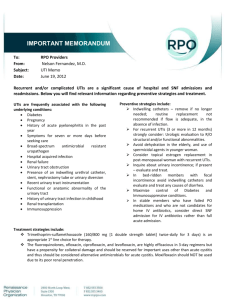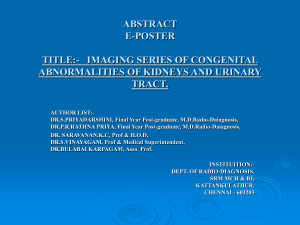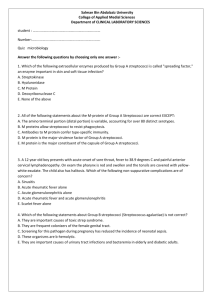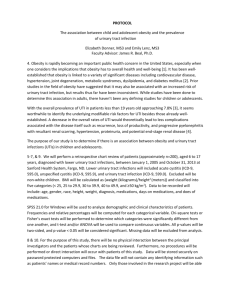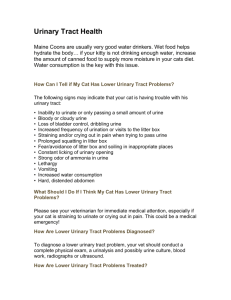diarrhoea chronic
advertisement
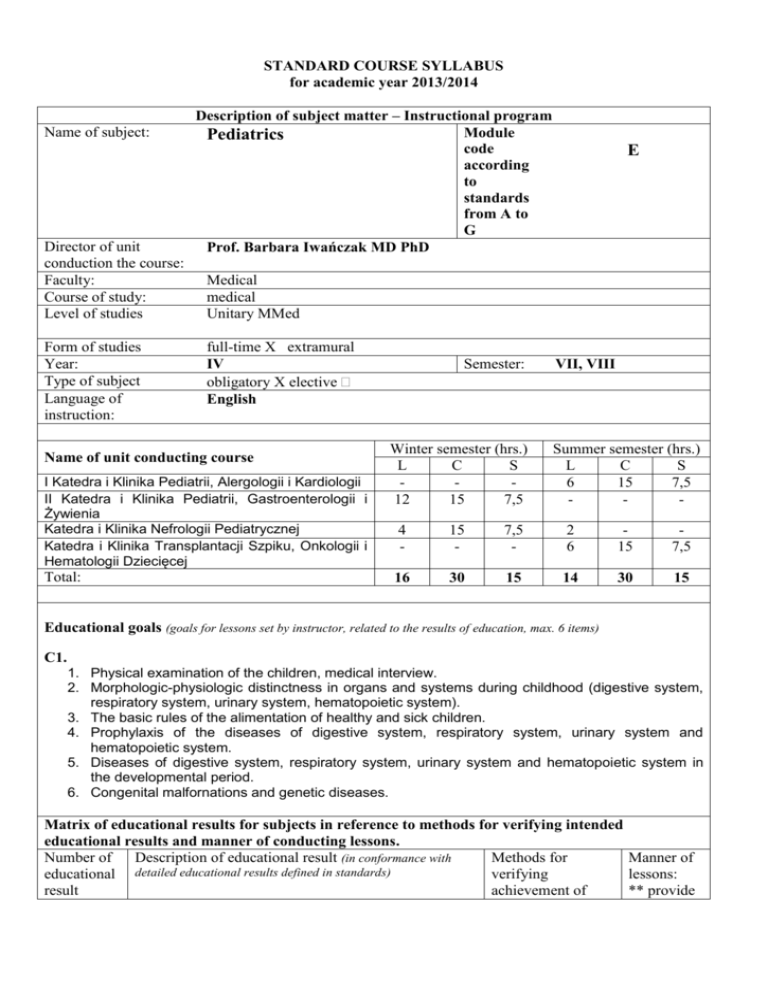
STANDARD COURSE SYLLABUS for academic year 2013/2014 Name of subject: Director of unit conduction the course: Faculty: Course of study: Level of studies Form of studies Year: Type of subject Language of instruction: Description of subject matter – Instructional program Module Pediatrics code according to standards from A to G Prof. Barbara Iwańczak MD PhD Medical medical Unitary MMed full-time X extramural IV obligatory X elective English Name of unit conducting course I Katedra i Klinika Pediatrii, Alergologii i Kardiologii II Katedra i Klinika Pediatrii, Gastroenterologii i Żywienia Katedra i Klinika Nefrologii Pediatrycznej Katedra i Klinika Transplantacji Szpiku, Onkologii i Hematologii Dziecięcej Total: E Semester: Winter semester (hrs.) L C S 12 15 7,5 VII, VIII Summer semester (hrs.) L C S 6 15 7,5 - 4 - 15 - 7,5 - 2 6 15 7,5 16 30 15 14 30 15 Educational goals (goals for lessons set by instructor, related to the results of education, max. 6 items) C1. 1. Physical examination of the children, medical interview. 2. Morphologic-physiologic distinctness in organs and systems during childhood (digestive system, respiratory system, urinary system, hematopoietic system). 3. The basic rules of the alimentation of healthy and sick children. 4. Prophylaxis of the diseases of digestive system, respiratory system, urinary system and hematopoietic system. 5. Diseases of digestive system, respiratory system, urinary system and hematopoietic system in the developmental period. 6. Congenital malfornations and genetic diseases. Matrix of educational results for subjects in reference to methods for verifying intended educational results and manner of conducting lessons. Number of Description of educational result (in conformance with Methods for Manner of detailed educational results defined in standards) educational verifying lessons: result achievement of ** provide intended educational results * oral response symbol E.W1. Knows environmental and epidemiological conditions of the most frequent diseases in children E.W2. Knows the basic rules of the alimentation of healthy and sick children, knows the basic rules of vaccination in children, knows the rules of monitoring of children’s health bilance oral response L, S, C E.W3. Knows and understands reasons, symptoms, diagnostic and therapeutic options in most often diseases in children oral response L, S, C L, S, C a) heart malformations, myocarditis, endocarditis, pericarditis, cardyomyopathy, heart rhythm abnormalities, heart failure, hypertension, syncope b) acute and chronic diseases of the upper and lower resoiratory tract, congenital malformations of the resoiratory tract, tuberculosis, cystic fibrosis, bronchial asthma, allergic rhinitis, urticaria, anaphylactic shock c) blood anemia, blood clotting disturbances, bone marrow failure, childhood malignancies, inc. solid tumors typical for childhood period d) acute and chronic abdominal pain, vomiting, diarrhoea, constipation, gastrointestinal bleeding, gastric and duodenal ulcer disesase, inflammatory bowel diseases, diseases of the pancreas, cholestasis, liver diseases, other congenital malformations and acquired diseases of the gastrointestinal tract, e) urinary tract infections, congenital malformations of the urinary tract, nephrotic syndrome, nephrolithiasis, acute and chronic renal failure, acute and chronic inflammatory diseases of the kidneys, disturbances in urination, vesicoureteral reflux disease E.W6. Knows the most often observed life-threatening events in children and knows therapeutic rules oral response L, S, C E.U2. Is able to perform medical interview with child and child’s family oral response L, S, C E.U4. Is able to perform complete physical examination of the child (from newborn to adolescent child) oral response L, S, C E.U7. Is able to estimate general appearance of the patient oral response L, S, C E.U9. Is able to compare anthropomethric results and results of blood pressure with values from percentile charts oral response L, S, C E.U12. Is able to perform the differential diagnosis of most often observed diseases in children oral response L, S, C E.U13. Is able to estimate and describe psychosomatic staus of the oral response L, S, C patient E.U14. Is able to recognize direct life-threatening events oral response L, S, C E.U16. Is able to make the plan of diagnostic, therapeutic and prophylactic procedures oral response L, S, C E.U17. Is able to make an analysis of interactions between drugs and drug side-effects oral response L, S, C E.U24. Is able to analyse results of laboratory tests oral response L, S, C E.U25. Is able to introduce nutritional therapy (inc. enteral and parenteral nutrition) oral response L, S, C E.U28. Is able to take biological material for laboratory diagnostics oral response L, S, C E.U29. Is able to perform basic medical procedures, incl.: a) measure of the body temperature, measure of the heart rate, noninvasive measure of the blood pressure, b) monitoring of the basic vital parameters using cardiomonitor, pulsoksymeter, c) spirometry testing, oxygen therapy, artifitial ventilation, d) intravenous infusions, intramuscular and subcutaneous injections, peripheral veins caniulation, collect blood samples from peripheral veins, collect blood samples for the blood culture, collect arterial blood samples, collect arterialised blood, e) collect samples from the nose, throat, skin, plural cavity, f) introduction the catheter in to urinary bladder, stomach, stomach lavage, enema, h) simple strip tests, glucose blood level oral response L, S, C E.U30. Assists medical pcoedures: a) blood transfusion, b) pleural cavity drainage, c) skin tests, d) intradermique and skaryphication tests and is able to interpretate tests results oral response L, S, C E.U32. Is able to plan specialistic consultations oral response L, S, C *e.g.. test, presentation, oral response, essay, report, colloquium, oral examination, written examination; ** L- lecture; S- seminar; C- class; EL- e-learning; Student work input (balance of ECTS points) Lessons on-site (hrs.) 120 Own work (hrs.) 39 Summary of student workload 159 ECTS points for subject 9 Remarks Content of lessons: (please provide the subject of individual lessons, keeping in mind the need to contribute to the intended educational results) Upper and lower respiratory tract inflammations. Laryngitis, tracheitis, pharyngitis. Brochitis, bronchiolitis. Clinical symptoms, diagnostic procedures, differential diagnosis. Viral, bacterial and atypical pneumoniae. Clinical symptoms in newborns, infants and children. Diagnostic procedures, treatment. Allergic diseases as a social problem, epidemiology, basics of ethiopatogenic mechanisms (environmental and genetics). Functional disorders of the gastrointestinal tract in infants and adolescents Chronic abdominal pain in children, symptomatology, current diagnostic procedures. Acute diarrhoea. Treatment of the water-base-electrolyte disturbances. Urinary tract infections. Diagnostics, clinical syptoms, treatment. Congenital malformations of the urinary tract, diagnostics, treatment, consequences. Acute renal failure: etiology, clinical syndromes, diagnostic procedures, treatment. Indications for dialisotherapy. Hematologic diseases in newborns. Blood anemias in children. Bleeding disorders in children. Lymphoproliferative diseases of the blood. Blood leucemias in children. Hodgkin’s and non-Hodgkin’s lymphomas in children. Allergic rhinitis. Allergic diseases of the skin in infants. Diagnostic allergic skin tests. Bronchial asthma, clinical symptoms, diagnostic procedures (functional tests of the respiratory tract), treatment. Lymphadenopathy and hepatosplenomegaly. Celiac disease and its manifestations in children. Chronic diarrhoea in children. Food intolerance and ford alergy. Diagnostics procedures, differential diagnostics. Maldigestion and malabsorption syndroms. Cystic fibrosis – clinical manifestations in children. Urinary lithiasis - etiology, diagnostic and therapeuthic procedures, risk factors of urinary lithiasis. Idiopathic nephrotic syndrome - ethiopatogenesis, morphologic types, clinical symptoms, recommendations for the treatment of the 1st time disease, clinical procedures in children with recurrent disease. Acute and chronic glomerulonephritis: etiology, clinical course of the disease, treatment. Histiocytosis. Myelodysplastic syndromem. Diagnostic and treatment of solid tumours in children. Bone tumours in children. Soft tissue tumours. Primary and secondary literature Nelson’s textbook of pediatrics. 18th Edition, Saunders 2007 Philips Lanzkowsky: Manual of Pediatric Hematology and Oncology, Elsevier Inc., 4 th ed., 2005 Requirements concerning instructional aids (e.g. laboratory, multimedia projector, other …) Conditions for successful completion of course: Attendence at classes (obligatory), clinical seminars (obligatory) and lectures (recommended), colloquium Name and address of unit conducting course, contact information (tel./email): II Katedra i Klinika Pediatrii, Gastroenterologii i Żywienia (with Depts listed on the head of the Syllabus Tel: 71-7703045; e-mail: gastrped@gastro.am.wroc.pl Person responsible for the course for a given year Prof. dr hab. med. Barbara Iwańczak Signature of head of unit conducting the course Signature of dean .………....…..… ……….………..…… Date of syllabus drafting: 31/07/2013
